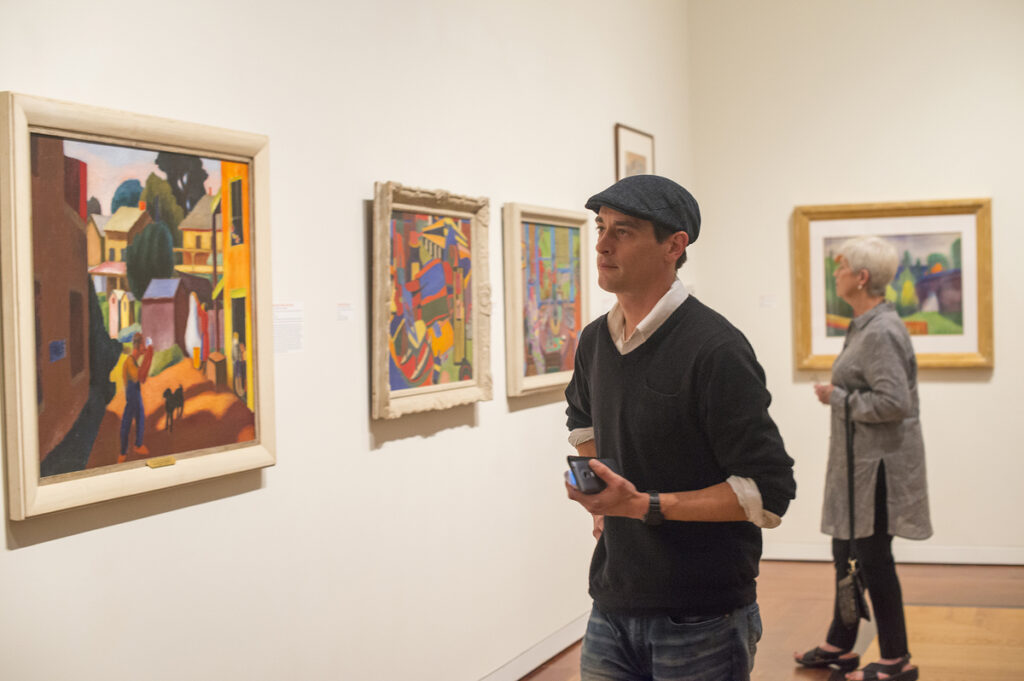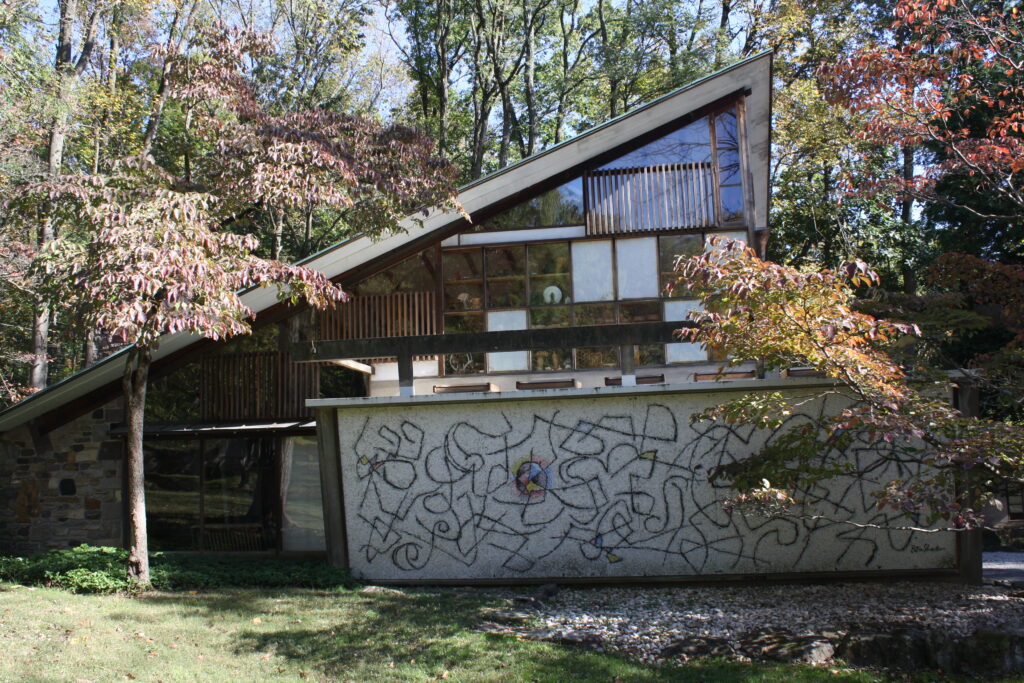When Oscar Hammerstein wrote, “Oh, What a Beautiful Mornin'” for the 1943 musical Oklahoma!, the song was actually about Bucks County.
Looking out over the rolling hills at Highland Farms, Hammerstein penned the lyrics to one of Broadway’s greatest songs while basking in the beauty of the Delaware Valley.
While cities often get all the attention as havens for creative types, this bucolic Pennsylvania county has cultivated an astounding legacy of writers, craftspeople and artists. In addition to spacious state parks, beautiful farmland, and vibrant towns, the area boasts museums, theaters, galleries and powerful artistic sites worth exploring.
***
Bucks County was founded in 1682 by William Penn, who named the county after Buckinghamshire, his family home in England. Penn was a proponent of religious tolerance, which helped attract immigrants coming to America in search of a better life and intellectual freedom.
That creed endured. The intensity of creative activity in Bucks County reached a peak between 1930 and 1950, when artists, playwrights, craftsmen, and writers moved to the area in droves, attracted by affordable land and proximity to major cities. The New York media began to refer to the cluster as “the Genius Belt.”
Pearl S. Buck, a Nobel Peace Prize and Pulitzer Prize-winning author, activist, and humanitarian, epitomized the county’s commitment to creativity and diversity. She worked tirelessly for the betterment of all people from her 69-acre farm near Perkasie, which today is a National Historic Landmark.

Touring the Pearl S. Buck House & Historic Site gives one a deeper appreciation for her works and her writing. It was here that she penned many of her more than 1,000 essays, children’s books, novels, and short stories.
Visitors can take a guided tour at the house, check out the cultural center, gardens, and exhibits, or walk the grounds, visiting her gravesite and seeing statutes that celebrate her life and social causes.
She was really able to understand all people, and while she’s been somewhat lost in history, her home represents the legacy she left and the bridges she built between cultures.
An especially poignant moment on the guided tour comes in the large library, where Buck’s quotes against hatred, intolerance and racial discrimination are beamed on the walls.
“Pearl Buck was a very influential and very unique person who had a different perspective than most people since she lived the first half of her life in China [as the child of missionaries],” explains museum curator Marie Toner. “She was really able to understand all people, and while she’s been somewhat lost in history, her home represents the legacy she left and the bridges she built between cultures. Her words are just as relevant today as when she wrote them.”

The large library also contains the chair, desk, and typewriter on which she wrote The Good Earth, her 1932 Pulitzer Prize-winning novel about village life in China. Guests can tour her office and take in the view of the farm, which is said to have sparked much of her creativity.
Down the road in Doylestown is the Michener Art Museum, which exists thanks to the professional relationship between lyricist Hammerstein and Doylestown native James A. Michener. His Pulitzer Prize-winning book Tales of the South Pacific was turned into the smash Broadway classic “South Pacific” by Rodgers & Hammerstein.
Royalties from the play allowed Michener to quit his day job to become a full-time writer, which led to novels such as Centennial, Hawaii and Texas. Herman Silverman, a local businessman, and his wife Ann convinced Michener to fund and open the art museum as a way to celebrate the artistic talents of local residents.

Founded in 1988, the Michener Art Museum is located in an old county jail. The institution is dedicated to “preserving, interpreting and exhibiting the art and cultural heritage of the Delaware Valley region” and houses a robust collection showcasing the artistic movement known as Pennsylvania Impressionism.
“The museum presents exhibits that explore a variety of artistic expressions and offers diverse educational programs that develop a lifelong involvement in the arts,” says Amy Ferracci, associate director of marketing and public relations. “The Michener collects, preserves, interprets and exhibits American art, and promotes the work of nationally and internationally known Delaware Valley artists of all eras and disciplines.”
George Nakashima, the “Elder Statesman of the American craft movement,” was another member of the Genius Belt. A trained architect turned furniture maker, Nakashima became one of the preeminent designer-craftsmen in the United States and a leading innovator of twentieth-century furniture design.

The 12-acre George Nakashima Woodworker Complex near New Hope contains 21 buildings — all designed by him — built in the 1950s and ‘60s. A National Historic Landmark open for public tours on Saturdays, the buildings are in the International Style and infused with elements of traditional Japanese architecture.
Although Nakashima died in 1990, the George Nakashima Studio continues to produce his furniture designs out of Pennsylvania hardwoods, preserving his methods and techniques through new works created by his daughter Mira Nakashina.
***
A great way to experience the sites of Bucks County is by car. This is especially true of the Route 32 Corridor, running north-south along the scenic Delaware River.
“The Route 32 Corridor is our version of the Pacific Coast Highway,” says Paul Bencivengo, vice president of Visit Bucks County. “There are antique shops, restaurants, general stores, and covered bridges to see along the way.”
At the northern end of the route In Upper Black Eddy is Ringing Rocks County Park. Here, visitors can make music of their own, creating beautiful sounds by hitting the outcrop of rocks with a hammer.

Heading south, guests can also tour a castle — Sand Castle Winery — in Erwinna. It is actually one of two castles located in Bucks County; the other is Fonthill Castle in Doylestown, home of American archeologist and tile maker Henry Chapman Mercer, who also founded Mercer Museum.
Two other stops of note along the corridor include Washington Crossing Historic Park, site of the infamous river crossing on Christmas during the Revolutionary War, and the town of New Hope, which is more than 200 years old.
New Hope is a small town with a big city feel, home to art galleries, eclectic shops, cultural attractions, a vibrant dining scene, and the Bucks County Playhouse, which opened its doors in the late 1930s.
The structure that would become the playhouse was built by Benjamin Parry in 1790 after the Hope Mills grist mill burned to the ground. Facing demolition in 1930, a group of actors and actresses and a local resident named Moss Hart banded together to save and renovate the historic structure into a theater.
Showbiz royalty to grace the stage include Alan Alda, Bea Arthur, Helen Hayes, Kitty Carlisle, George C. Scott, Liza Minnelli, Keven Kline, John Lithgow, Dick Van Dyke and Jessica Tandy.
The playhouse’s curtain first rose on July 1, 1939 with a rousing production of Springtime for Henry, featuring Edward Everett Horton.
During its illustrious history, the playhouse has featured countless legendary actors and actresses who traveled the short distance — 90 miles — from the bright lights of Broadway to perform at what came to be known as “America’s Most Famous Summer Theater.” (Bucks County also offered performers a respite from the oppressive summer heat in the days before air conditioning.)
Showbiz royalty to grace the stage include Alan Alda, Bea Arthur, Helen Hayes, Kitty Carlisle, George C. Scott, Liza Minnelli, Keven Kline, John Lithgow, Dick Van Dyke and Jessica Tandy. Click here for its current slate of offerings.

Also located near the Route 32 corridor is the town of Lashaka, home to Peddler’s Village, an opportunity to take something made in Bucks County home with you. The 42-acre attraction was constructed on an old poultry farm called “Hentown” by lifelong Bucks County resident Earl Jamison. Jamison renovated an old barn and the chicken coops to house merchant’s shops, using the land and the existing architecture to create a charming aesthetic.
Today Peddler’s Village is home to 65 shops, including numerous art galleries, family-owned businesses that create unique handcrafted items, and local breweries and wineries. During the holidays, one million lights illuminate the night in celebration of the season.
With a rich history as the third oldest county in Pennsylvania, numerous modern art galleries throughout the region, and varied cultural attractions for every taste, it’s easy to see why a visit to Bucks County will have you singing “O, what a beautiful day!”



